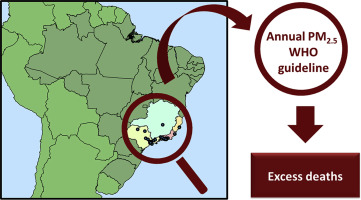当前位置:
X-MOL 学术
›
Atmos. Environ.
›
论文详情
Our official English website, www.x-mol.net, welcomes your
feedback! (Note: you will need to create a separate account there.)
Excess deaths associated with fine particulate matter in Brazilian cities
Atmospheric Environment ( IF 4.2 ) Pub Date : 2018-12-01 , DOI: 10.1016/j.atmosenv.2018.09.034 Willian L. Andreão , Taciana T.A. Albuquerque , Prashant Kumar
Atmospheric Environment ( IF 4.2 ) Pub Date : 2018-12-01 , DOI: 10.1016/j.atmosenv.2018.09.034 Willian L. Andreão , Taciana T.A. Albuquerque , Prashant Kumar

|
Abstract Fine particulate matter (PM 2.5 ; ≤2.5 μm in aerodynamic diameter) stands out among all pollutants as more directly responsible for long-term health problems. This work aims to evaluate the public health benefits of improved air quality in Brazil, based on the estimated reduction in mortality from PM 2.5 , a pollutant commonly related to all causes mortality including non-accidental, cardiovascular, ischemic heart diseases and lung cancer. Annual PM 2.5 concentrations were obtained from 50 monitoring stations spread across 24 Brazilian cities between the years 2000 and 2017, which constituted the baseline scenario. The control scenario was represented by the annual PM 2.5 guideline values (10 μg m −3 ) of the World Health Organization (WHO). The relationship between the change in baseline and control scenarios with health effects was estimated using the BenMAP-CE program and the application of exposure-response functions. Sao Paulo city showed the highest number of avoidable deaths, with values ranging from 28,874 ± 9769 and 82,720 ± 24,549 for all causes from 2000 to 2017. In 2009, just three Brazilian cities were monitoring PM 2.5 . Between 877 ± 295 and 2497 ± 719 all causes avoidable deaths related to PM 2.5 were estimated under the scenario when the WHO guideline was applied. In 2017, the 15 cities with representative annual PM 2.5 data account for between 2378 ± 801 and 6282 ± 1818 avoidable deaths due to all-cause PM 2.5 mortality, between 2974 ± 376 and 10,397 ± 516 avoidable deaths due non-accidental causes, between 1373 ± 230 and 3428 ± 265 avoidable deaths due cardiovascular disease, between 927 ± 162 and 2514 ± 156 avoidable deaths due ischemic heart diseases and the lowest between 101 ± 45 and 264 ± 88 avoidable deaths due to lung cancer.
中文翻译:

巴西城市中与细颗粒物相关的超额死亡人数
摘要 细颗粒物(PM 2.5 ;空气动力学直径≤2.5 μm)在所有污染物中脱颖而出,因为它更直接地导致长期健康问题。这项工作旨在根据 PM 2.5 的死亡率估计降低来评估巴西改善空气质量的公共健康益处,PM 2.5 是一种污染物,通常与所有原因的死亡率有关,包括非意外、心血管、缺血性心脏病和肺癌。从 2000 年到 2017 年间分布在巴西 24 个城市的 50 个监测站获得了年度 PM 2.5 浓度,这构成了基线情景。控制情景由世界卫生组织 (WHO) 的年度 PM 2.5 指导值 (10 μg m -3 ) 表示。使用 BenMAP-CE 程序和暴露-反应函数的应用估计基线和控制情景的变化与健康影响之间的关系。圣保罗市的可避免死亡人数最多,从 2000 年到 2017 年,所有原因的死亡人数分别为 28,874 ± 9769 和 82,720 ± 24,549。2009 年,只有三个巴西城市监测 PM 2.5。在应用 WHO 指南的情景下,估计与 PM 2.5 相关的所有原因可避免的死亡人数介于 877 ± 295 和 2497 ± 719 之间。2017 年,具有代表性年度 PM 2.5 数据的 15 个城市占 2378±801 至 6282±1818 起可避免的 PM 2.5 全因死亡率死亡,2974±376 至 10397±516 起非意外原因可避免的死亡,
更新日期:2018-12-01
中文翻译:

巴西城市中与细颗粒物相关的超额死亡人数
摘要 细颗粒物(PM 2.5 ;空气动力学直径≤2.5 μm)在所有污染物中脱颖而出,因为它更直接地导致长期健康问题。这项工作旨在根据 PM 2.5 的死亡率估计降低来评估巴西改善空气质量的公共健康益处,PM 2.5 是一种污染物,通常与所有原因的死亡率有关,包括非意外、心血管、缺血性心脏病和肺癌。从 2000 年到 2017 年间分布在巴西 24 个城市的 50 个监测站获得了年度 PM 2.5 浓度,这构成了基线情景。控制情景由世界卫生组织 (WHO) 的年度 PM 2.5 指导值 (10 μg m -3 ) 表示。使用 BenMAP-CE 程序和暴露-反应函数的应用估计基线和控制情景的变化与健康影响之间的关系。圣保罗市的可避免死亡人数最多,从 2000 年到 2017 年,所有原因的死亡人数分别为 28,874 ± 9769 和 82,720 ± 24,549。2009 年,只有三个巴西城市监测 PM 2.5。在应用 WHO 指南的情景下,估计与 PM 2.5 相关的所有原因可避免的死亡人数介于 877 ± 295 和 2497 ± 719 之间。2017 年,具有代表性年度 PM 2.5 数据的 15 个城市占 2378±801 至 6282±1818 起可避免的 PM 2.5 全因死亡率死亡,2974±376 至 10397±516 起非意外原因可避免的死亡,











































 京公网安备 11010802027423号
京公网安备 11010802027423号